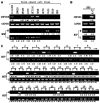Downregulation of ZNF365 by methylation predicts poor prognosis in patients with colorectal cancer by decreasing phospho-p53 (Ser15) expression
- PMID: 32863918
- PMCID: PMC7436887
- DOI: 10.3892/ol.2020.11946
Downregulation of ZNF365 by methylation predicts poor prognosis in patients with colorectal cancer by decreasing phospho-p53 (Ser15) expression
Abstract
ZNF365 is a transcription factor that plays important roles in different types of cancer, such as colorectal cancer, breast cancer and hepatocellular carcinoma. ZNF365 can promote stalled replication fork recovery to prevent genomic instability, which is a notable feature of sporadic and hereditary types of cancers. However, the function of ZNF365 in the tumor progression of colorectal cancer (CRC) remains unclear. Thus, immunohistochemical staining was used to investigate the association between ZNF365 expression and the clinicopathological characteristics of patients with colorectal cancer. The results demonstrated that ZNF365 protein was strongly expressed in the nucleus and cytoplasm of normal colorectal mucosa. Furthermore ZNF365, which is methylated and downregulated in most cancer cell lines and tissues, was significantly associated with lymph node metastasis (P=0.015), depth of invasion (P=0.031) and histopathological grading (P=0.042). A positive correlation was observed between ZNF365 expression and phosphorylated (P)-p53 (Ser15) protein expression (r=0.18; P=0.038). Survival analysis indicated that patients with high ZNF365 expression had a higher survival rate than those with low ZNF365 expression (P=0.009), suggesting that ZNF365 may be an independent prognostic factor for survival in colorectal cancer (P=0.046). Taken together, the results of the present study demonstrated that ZNF365 was frequently inactivated by promoter methylation and independently predicted poor prognosis in patients with colorectal cancer by downregulating P-p53 (Ser15) expression.
Keywords: DNA methylation; ZNF365; colorectal cancer; immunohistochemistry.
Copyright: © Wang et al.
Figures







References
LinkOut - more resources
Full Text Sources
Molecular Biology Databases
Research Materials
Miscellaneous
